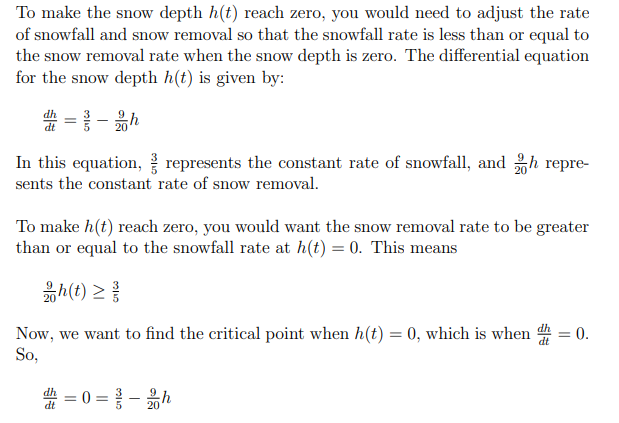we are given this situation: snow is falling at a constant rate of 3/5 in per hour and is being removed at a constant rate of 45% of the amount of snow on the ground per hour. The height of snow as a function of time is h(t) where our initial condition is h(0)=4. Our differential equation would thus be dh/dt = 3/5 - (9/20)h. Solving this gives h(t)=4/3 + (8/3)e^(-(9/20)t). All of the snow cannot be removed under these conditions because we cannot solve for h(t)=0 because it is undefined. The lowest the snow can reach is about 4/3 inches. But how could we change the rate of snowfall and rate of snow removal so that h(t) could equal zero?
we are given this situation: snow is falling at a constant rate of 3/5 in per hour and is being removed at a constant rate of 45% of the amount of snow on the ground per hour. The height of snow as a function of time is h(t) where our initial condition is h(0)=4. Our differential equation would thus be dh/dt = 3/5 - (9/20)h. Solving this gives h(t)=4/3 + (8/3)e^(-(9/20)t). All of the snow cannot be removed under these conditions because we cannot solve for h(t)=0 because it is undefined. The lowest the snow can reach is about 4/3 inches. But how could we change the rate of snowfall and rate of snow removal so that h(t) could equal zero?
Advanced Engineering Mathematics
10th Edition
ISBN:9780470458365
Author:Erwin Kreyszig
Publisher:Erwin Kreyszig
Chapter2: Second-order Linear Odes
Section: Chapter Questions
Problem 1RQ
Related questions
Question
100%
we are given this situation: snow is falling at a constant rate of 3/5 in per hour and is being removed at a constant rate of 45% of the amount of snow on the ground per hour. The height of snow as a function of time is h(t) where our initial condition is h(0)=4. Our differential equation would thus be dh/dt = 3/5 - (9/20)h. Solving this gives h(t)=4/3 + (8/3)e^(-(9/20)t). All of the snow cannot be removed under these conditions because we cannot solve for h(t)=0 because it is undefined. The lowest the snow can reach is about 4/3 inches. But how could we change the rate of snowfall and rate of snow removal so that h(t) could equal zero?
Expert Solution
Step 1: Solution

Step by step
Solved in 3 steps with 2 images

Recommended textbooks for you

Advanced Engineering Mathematics
Advanced Math
ISBN:
9780470458365
Author:
Erwin Kreyszig
Publisher:
Wiley, John & Sons, Incorporated

Numerical Methods for Engineers
Advanced Math
ISBN:
9780073397924
Author:
Steven C. Chapra Dr., Raymond P. Canale
Publisher:
McGraw-Hill Education

Introductory Mathematics for Engineering Applicat…
Advanced Math
ISBN:
9781118141809
Author:
Nathan Klingbeil
Publisher:
WILEY

Advanced Engineering Mathematics
Advanced Math
ISBN:
9780470458365
Author:
Erwin Kreyszig
Publisher:
Wiley, John & Sons, Incorporated

Numerical Methods for Engineers
Advanced Math
ISBN:
9780073397924
Author:
Steven C. Chapra Dr., Raymond P. Canale
Publisher:
McGraw-Hill Education

Introductory Mathematics for Engineering Applicat…
Advanced Math
ISBN:
9781118141809
Author:
Nathan Klingbeil
Publisher:
WILEY

Mathematics For Machine Technology
Advanced Math
ISBN:
9781337798310
Author:
Peterson, John.
Publisher:
Cengage Learning,

